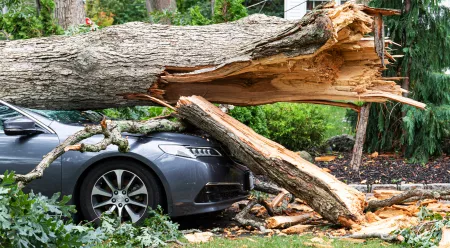At a basic level, the best snowmobile helmet is one that offers protection and comfort. However, there are many other features to consider when shopping for a snowmobile helmet. In this article, we’ll take a look at six different helmets and discuss what they’re best suited for.
6 Best Snowmobile Helmets
Note that these aren’t in any particular order. Rather, we’ve organized them into categories based on different uses and styles.
Best Modular Snowmobile Helmet: Castle X Exo CX950
Modular snowmobile helmets are great for riders seeking versatility. They’re a hybrid between open-face and full-face helmets, allowing you to easily catch their breath or speak with others on the trail in between runs.
The Castle X Exo CX950 scores points for being solidly-built and aesthetically pleasing while still not costing a fortune. One reviewer also noted its ability to reduce trail noise, helping you focus on riding.
Additionally, the Castle X Exo CX950 comes with a breath box, which is an apparatus that reduces the likelihood of the helmet’s visor fogging up.
These features help make the Castle X Exo CX950 one of the best modular snowmobile helmets out there.
Best Full-Face Snowmobile Helmet: HJC Solid Men’s CS-R2
HJC is one of the most renowned motorcycle helmet manufacturers in the world. The company’s snowmobile helmets are also high-quality, with the CS-R2 being one of the most popular options.
It’s a full-face helmet, offering substantially more protection against frontal impacts than a modular unit. In exchange for this, you sacrifice a bit of comfort in that you won’t be able to flip a chin guard down and get some fresh air.
However, full-face helmets are unmatched in terms of safety, making them very popular among racers.
Speaking of safety, the CS-R2 also offers a heated face shield, helping you maintain good visibility even in the snow. This, along with HJC’s reputation for quality, makes the CS-R2 easily one of the best full-face snowmobile helmets currently on the market.
Best Open-Face Snowmobile Helmet: CKX VG1000 RSV
Open-face snowmobile helmets are popular among casual riders who rarely venture beyond certain speeds or below certain temperatures.
As their name suggests, open-face helmets offer less protection than other variants but make it easier to communicate and catch some fresh air without having to move anything out of place.
The CKX VG1000 RSV is arguably the best open-face snowmobile helmet because it is solidly built and comes with an installed visor, which means your face won’t be completely unprotected from the elements.
It’s also very reasonably priced, which the casual users more likely to purchase open-face helmets will appreciate.
Best Snocross Helmet: 509 Tactical Snowmobile Helmet
Among snocross enthusiasts, Ride 509’s Tactical Helmet is near ubiquitous. It’s perfect for those who want a high-quality and safe helmet yet have their own goggles and breath box to use.
The 509 Tactical Helmet also scores points for fitting true to size and being reassuringly weighty while not overbearing.
Ski-Doo Modular 3 Helmet
If you want a modular helmet but aren’t a fan of their characteristically ‘busy’ look, the Ski-Doo Modular 3 is worth considering.
Ski-Doo, the famous snowmobile manufacturer, designed its modular helmet from the ground-up and has made consistent revisions. In this latest version, the helmet comes with Clear Vision Technology and a convenient button-adjusted sun visor.
The chin guard is also designed to fit deceptively well into the design, making the Ski-Doo Modular 3 appear almost like a full-face helmet.
Fly Racing Trekker Helmet
One last modular helmet worth considering is the Fly Racing Trekker. It scores for its ability to transform into what’s essentially an open-face helmet, compatible with your own goggles.
The inner liner is both hydrophilic and removable, allowing you to wash it after a particularly intense session on the trail.
What is the Best Snowmobile Helmet for You?
Now that you know our picks for the best snowmobile helmets currently on the market, let’s take a look at some tips for choosing the right one.
Know the Types of Helmets
Much like with choosing the right snowmobile, choosing a helmet starts with knowing which type best suits your intended use. We touched on the main types earlier but let’s recap.
Modular snowmobile helmets are popular among riders who want the comfort of an open-face helmet mixed with the protection of a full-face helmet. They tend to be on the sportier side and have lots of moving parts.
Open-face helmets tend to be fairly no-frills in their design. They offer optimal comfort but you sacrifice for this by giving up some impact protection, making them better for casual riders.
Full-face helmets, as you might imagine, offer the most protection and are popular among riders who race at high speeds or venture out during the colder months.
Lastly, snocross helmets are designed to be paired with a rider’s own goggles and other protective equipment. In this way, they mimic open-face helmets but are styled much more aggressively to accommodate for rougher intended usage.
Get the Best Helmet You Can Afford
One thing to avoid when shopping for a snowmobile helmet is choosing a type based solely on your budget. Research shows that, unsurprisingly, head injury is the most common cause of death in snowmobile accidents.
In other words, don’t choose an open-face helmet for its traditionally lower cost if what you really need is a full-face helmet. If snowmobiling is something you take seriously, getting the right helmet will be more than worth it.
Carefully Consider Lenses, Too
A helmet’s lens is another very important component to consider. The best snowmobile helmets today come with dual-pane lenses and anti-fog technology that keeps condensation from forming a dangerous visibility blocker inside your helmet.
Another advantage of dual-pane lenses is that they offer protection from impacts and objects (i.e. branches, rocks, and other debris) that could damage your eyes while riding at high speeds.
If you ride in particularly cold weather, consider also purchasing a helmet with a heated shield, such as the HJC Solid Men’s CS-R2. The heating component is just one more assurance you’ll have against fogging.
One last thing to note related to visors is that frames are no longer an indicator of quality. Years ago, dual-pane snowmobile visors invariably came with frames to hold the panes together. Modern technology means this is no longer necessary.
Choose the Right Breath Guard
If you breathe particularly heavily, you’ll want a breath guard that fits as tightly as possible around your lower face. This will ensure your exhales are directed downward rather than potentially fogging up your visor.
If you already have a standalone breath guard you like, make sure the helmet you buy is compatible with it.
Know the Safety Ratings
If you plan on participating in organized snowmobile activities, make sure your helmet falls in line with the required safety ratings.
At the very least, your snowmobile helmet should meet the safety requirements set by your province’s ministry of transportation. There are also independent rating systems like SNELL that can give you a fair understanding of how safe your helmet is. Pay attention to your snowmobile's safety ratings as well. Check out a list of the most reliable snowmobile brands.
Conclusion
Snowmobile helmets come in a variety of styles designed for different uses. We hope this article has been helpful in showing you a few of the best snowmobile helmets currently available.
While a helmet will protect your head, snowmobile insurance is crucial for protecting your wallet. Learn more about how Surex helps Canadians find the best insurance rates for snowmobiles.
Frequently Asked Questions
What is the best snowmobile helmet?
The best snowmobile helmet depends on your intended usage. If you’re a casual rider, an open-face helmet will likely suffice. Modular and open-face helmets are for those who want comfort with added protection while snocross helmets are ideal for those in need of a sportier helmet that’s compatible with their existing gear.
How do I choose a snowmobile helmet?
Once you’ve identified the correct style of helmet for your needs, find one within your budget that has the appropriate safety ratings.
Why are modular helmets considered safer?
Modular helmets combine the protection of a full-face helmet with the convenience of an open-face one.
They’re also safer in the event of an accident as well since first responders will be able to access your airway without taking the helmet off your head. This avoids the potential for exacerbation of any neck injuries.
Should I get a helmet with a shaded visor?
Shaded visors are nice if you don’t have a pair of sport-rated sunglasses to use on the trail. By purchasing a helmet with a shaded visor, you’ll benefit from being able to remove the UV protection without stopping and taking your helmet off – something not possible with sunglasses.
For this reason, it’s generally recommended that you purchase a helmet with a shaded visor.
Why buy a breath guard when I can just make one myself?
A breath guard is one of a snowmobile rider’s most important pieces of equipment. It prevents fogging of the visor, which is why it’s better to stick with tried and true commercially-made visors than to create one yourself.
How often should your snowmobile helmet be replaced?
You should plan on replacing your snowmobile helmet roughly every five years, even if you’re never in a major collision. The reasoning behind this is that snowmobile helmets become brittle as time wears on, offering less protection against impacts.
If you’re ever in an accident (or even drop your helmet onto a hard surface), replace it as soon as possible.
What is the lightest snowmobile helmet?
The 509 Altitude Helmet is among the lightest snowmobile helmets yet still offers good protection. It’s made from a thermoplastic material.



